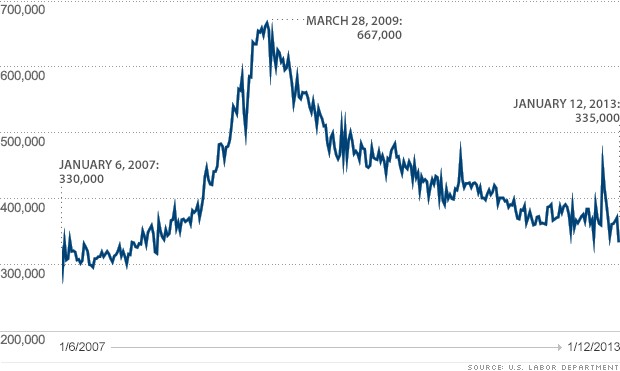
The number of Americans seeking unemployment benefits fell last week to the lowest level in five years, evidence that employers were cutting fewer jobs and may step up hiring.
The Labor Department said Thursday that weekly unemployment benefit applications dropped 5,000 to a seasonally adjusted 330,000. That is the fewest since January 2008.
The four-week average of jobless claims, a less volatile measure, fell to 351,750. That is also the lowest in nearly five years.
The decline may reflect the government’s difficulty adjusting its numbers to account for layoffs after the holiday shopping season. Layoffs spike in the second week of January and then plummet. The department seeks to adjust for those seasonal trends, but the figures can still be volatile.
If the trend holds up, fewer applications would suggest that the job market is improving.
“Encouraging news on the U.S. jobs front, even when you remove all of the noise,” said Jennifer Lee, an economist at BMO Capital Markets. “Weekly data are noisy, particularly at this time of year, so keep that in mind.”
Applications are a proxy for layoffs. They have fluctuated between 360,000 and 390,000 for most of last year. At the same time, employers added an average of 153,000 jobs a month. That has just been enough to slowly push down the unemployment rate, which fell 0.7 percentage points last year to 7.8 percent in December. The government will issue its January employment report at the end of next week.
The number of people continuing to claim jobless benefits is also falling. Nearly 5.7 million people were receiving unemployment aid in the week ended Jan. 5, the latest data available. That is down from almost 5.9 million in the previous week.
Separately, a measure of the American economy intended to signal future activity increased in December from November, suggesting growth might strengthen in early 2013.
The Conference Board said on Thursday that its index of leading indicators rose 0.5 percent in December, the best showing since September. In November, the index was unchanged.
The gauge is meant to forecast economic conditions three to six months out.
A decline in applications for unemployment benefits, stock market gains on Wall Street and increases in applications for building permits drove the index higher in December.
Kenneth Goldstein, a Conference Board economist, said the rebound in the leading indicators suggested an improving outlook, in contrast to a few months ago when the expectations were not so optimistic.
“Housing, which has long been a drag, has turned into a positive for growth, and will help improve consumer balance sheets and strengthen consumption,” Mr. Goldstein said. “However, for growth to gain more traction we also need to see better performance on new orders and an acceleration in capital spending.”



No comments:
Post a Comment